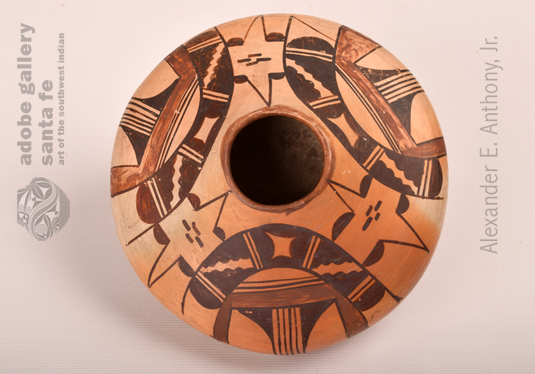Hopi-Tewa Early Polychrome Jar by Nampeyo [SOLD]
+ Add to my watchlist Forward to Friend
- Category: Historic
- Origin: Hopi Pueblo, Hopituh Shi-nu-mu
- Medium: clay, pigment
- Size: 3-½” height x 6-¼” diameter
- Item # C4165A SOLD
Thomas Keam opened a trading post on the Hopi Reservation in 1875, serving Navajo Nation and Hopi Pueblo, who came with goods to trade—hides, sheepskins, blankets, rugs, baskets and pottery. By 1879, the Smithsonian expressed interest in collecting from Southwest tribes before they were assimilated into the Anglo culture. Over the next decade, tens of thousands of cultural items were taken from the villages at Hopi, both contemporary wares and prehistoric wares.
The Hopi had become wary of English-speaking intruders to their reservation because of their constant attempts to change Hopi ways. There were Government people and missionaries intruding into the lives of the Hopi. Very few Hopi spoke English, but many spoke Hopi, Tewa, Navajo and Spanish. Tom Polacca, a Hopi-Tewa, had a shop at First Mesa and he was one of the few who spoke some English. He was the brother of Nampeyo of Hano and it was for that reason that Thomas Keam, a young man the same age as Tom Polacca, struck up a friendship with Polacca and was introduced to Nampeyo.
In the early days of her career, Nampeyo made pottery for family use and occasionally for sale. After meeting Thomas Keam, she was encouraged to make more for sale. He recognized her as the finest potter on the reservation. She spent the remainder of her life making pottery that found its way to museums and private collections.
One of the vessel shapes Nampeyo made in the early 1900s was a seed jar with a wall sloping in from the mid-body in an almost straight line to the opening at the top. She tended to place designs of butterflies or moths on the walls of that vessel shape. She apparently also placed designs inspired by Sikyatki vessels being discovered at the time.
This small jar is one of those with that beautiful vessel shape. On this one, however, she used a design inspired by Sikyatki pottery. It is an early interpretation of what would eventually develop into the eagle tail design seen on pottery by Nampeyo and members of many generations of her descendants. That design is the one with a red frame from which are black triangles and parallel black lines. It is easy to see that this was the foundation from which the eagle tail design developed. Other designs on the jar are also early elements from Sikyatki pottery.
This jar, with its vessel shape and early use of Sikyatki-inspired designs, is classic Nampeyo. It clearly shows her talent for vessel shape and design appropriate to that shape. Nampeyo was a true artist and proved over and over during her career that she never lacked enthusiasm for creating masterpieces in clay.
Condition: this Hopi-Tewa Early Polychrome Jar by Nampeyo is in very good condition
Provenance: from the collection of a gentleman from Texas
Recommended Reading: Canvas of Clay: Seven Centuries of Hopi Ceramic Art by Edwin L. Wade and Allan Cooke
Note: when we say Diné, as opposed to Navaho or Navajo, we are referring to the people and not the government. Since 1969, their government refers to itself as the Navajo Nation.
Pueblo Languages:
- Hopi: the language spoken by the Puebloan people of Hopi, Arizona.
- Keres: the language spoken by the Puebloan people of Acoma, Cochiti, Laguna, San Felipe, Santa Ana, Santo Domingo, and Zia Pueblos are so closely related that linguists usually consider them dialects of a single language, known as Keres or Keresan.
- Tewa or Tano: one of three Kiowa-Tanoan languages spoken by the Pueblo people of New Mexico. Though these three languages are closely related, speakers of one cannot fully understand speakers of another. The six Tewa-speaking pueblos are Nambe, Pojoaque, San Ildefonso, San Juan, Santa Clara, and Tesuque.
- Tiwa: one of three Kiowa-Tanoan languages spoken by the Pueblo people of New Mexico. Though these languages are closely related, speakers of one cannot fully understand speakers of another. Many Tiwa elders believe that their language is not intended to be written and must be preserved by oral traditions alone. Some Tiwa people disagree with this position and think that using Tiwa as a written language will help keep it alive for future generations. The five Tiwa-speaking pueblos are Isleta, Picuris, Sandia, Taos, Tigua (Ysleta del Sur Pueblo).
- Towa or Jemez: the language spoken by the Puebloan people of Jemez.
- Zuñi: the language spoken by the Puebloan people of Zuni.

- Category: Historic
- Origin: Hopi Pueblo, Hopituh Shi-nu-mu
- Medium: clay, pigment
- Size: 3-½” height x 6-¼” diameter
- Item # C4165A SOLD



